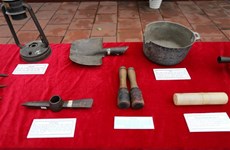New water system boosts rice production
A nine-year pilot project deploying an
integrated water management system has proved its efficacy and has the
potential for much wider application, experts said at a workshop in the
Mekong Delta province of An Giang Province last week.
A nine-year pilot project deploying an
integrated water management system has proved its efficacy and has the
potential for much wider application, experts said at a workshop in the
Mekong Delta province of An Giang Province last week.
The workshop brought together local authorities, officials and experts in irrigation, agriculture and rural development in the Mekong Delta provinces, seeking to exchange experiences and lessons learnt from the pilot project.
The North Vam Nao Water Control Project, the first of its kind with a modern and unified water management model, was built and operated on An Giang's North Vam Nao Island between 2002 and 2010 with support from the Australian Government.
The first phase of the project which ended in 2007, cost 35.7 million AUS (29.7 million USD), with 17.5 million AUS granted by AusAID and the remaining taken from the State budget.
Five old sluices were upgraded or replaced and 11 new sluices built during the first phase of the project. It also upgraded a 100-km ring dyke system to meet set safety standards, increasing its height to 5.7m. Within this system, a further 300km of dykes in the 24 compartments that the project area was divided into were upgraded to reach a height of 4m.
Roads, power lines, solid waste collection and clean water supply stations were also built during the period.
The second phase, implemented at a cost of 950,000 AUS, sought to consolidate the operation of the integrated water management system as well as enhance the capacity of the institutions responsible for operating and maintaining it. This phase was implemented between 2008 and 2010.
The North Vam Nao Scheme Management Board will be responsibile for the management of the plan in the long term, said Kerry Groves, AusAID Counsellor.
"The people of North Vam Nao Island are now living without the threat of annual flooding, and their agricultural productivity, health and livelihoods have been improved," he said.
The water management system had benefited nearly 270,000 local residents in the project area by allowing them to triple-crop on land formerly inundated during the flooding season, increasing rice production by nearly 50 percent, said Huynh The Nang, deputy director of An Giang Province People's Committee.
The increased rice productivity had created more jobs and reduced poverty in the area, he added.
It also facilitated road transportation during the flood season and reduced flood damage to households, infrastructure and livelihood.
Climate change and water shortages in the dry season are among the challenges facing the project in the future, he said.
"The community consultation done to receive opinions and expectations from the local people to ensure that the voice of the farmers are heard and the highest benefits attained for them is one of the most important things to learn from the project," said Huynh Phuoc Hai, an executive officer in the irrigation sector under Tien Giang Province's Department of Agriculture and Rural Development.
The periodical environmental impact assessments done to monitor environmental changes after the new water management system was put into operation should be applied to other irrigation projects, Hai said./.
The workshop brought together local authorities, officials and experts in irrigation, agriculture and rural development in the Mekong Delta provinces, seeking to exchange experiences and lessons learnt from the pilot project.
The North Vam Nao Water Control Project, the first of its kind with a modern and unified water management model, was built and operated on An Giang's North Vam Nao Island between 2002 and 2010 with support from the Australian Government.
The first phase of the project which ended in 2007, cost 35.7 million AUS (29.7 million USD), with 17.5 million AUS granted by AusAID and the remaining taken from the State budget.
Five old sluices were upgraded or replaced and 11 new sluices built during the first phase of the project. It also upgraded a 100-km ring dyke system to meet set safety standards, increasing its height to 5.7m. Within this system, a further 300km of dykes in the 24 compartments that the project area was divided into were upgraded to reach a height of 4m.
Roads, power lines, solid waste collection and clean water supply stations were also built during the period.
The second phase, implemented at a cost of 950,000 AUS, sought to consolidate the operation of the integrated water management system as well as enhance the capacity of the institutions responsible for operating and maintaining it. This phase was implemented between 2008 and 2010.
The North Vam Nao Scheme Management Board will be responsibile for the management of the plan in the long term, said Kerry Groves, AusAID Counsellor.
"The people of North Vam Nao Island are now living without the threat of annual flooding, and their agricultural productivity, health and livelihoods have been improved," he said.
The water management system had benefited nearly 270,000 local residents in the project area by allowing them to triple-crop on land formerly inundated during the flooding season, increasing rice production by nearly 50 percent, said Huynh The Nang, deputy director of An Giang Province People's Committee.
The increased rice productivity had created more jobs and reduced poverty in the area, he added.
It also facilitated road transportation during the flood season and reduced flood damage to households, infrastructure and livelihood.
Climate change and water shortages in the dry season are among the challenges facing the project in the future, he said.
"The community consultation done to receive opinions and expectations from the local people to ensure that the voice of the farmers are heard and the highest benefits attained for them is one of the most important things to learn from the project," said Huynh Phuoc Hai, an executive officer in the irrigation sector under Tien Giang Province's Department of Agriculture and Rural Development.
The periodical environmental impact assessments done to monitor environmental changes after the new water management system was put into operation should be applied to other irrigation projects, Hai said./.













